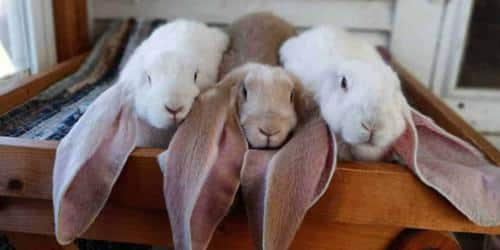English lop rabbits are best recognized for their large, floppy ears that, as adults, drag the ground. These ears are really beneficial for temperature control. They were among the first rabbits to be bred for display, and their outstanding disposition has made them popular domestic pets. Because these are not extremely active animals, they are prone to growing overweight. Do you want to learn more about this fantastic fuzzy pet? Continue reading!
A Brief History of the English Lop Rabbit
All domesticated rabbits are thought to have descended from a single species, the European Wild Rabbit. Domestic rabbits have been popular in England since the 1800s, but they did not make their way to the United States until the early 1900s. Lop-eared rabbits have been seen in artwork in China since the 1500s and may be traced back to the 1700s in England, making it one of the oldest rabbit breeds.
The English Lop is thought to have been produced as a fancy breed in England in the nineteenth century by selective breeding; it is perhaps the first breed of lop-eared rabbit ever developed by humans.
Read Also: Rabbit Farming in Nigeria: Everything You Need To Know
It was during the Victorian era (the reign of England’s Queen Victoria from 1837 to 1901) when rabbit breeds became popular and were kept indoors as house rabbits, as people realized they made excellent pets. Prior to the Victorian era, luxury rabbit breeds were mostly created for meat, fur, wool, or rabbit shows, rather than as pets.
The English Lop rabbit, the first of the Lop varieties, was a tremendously popular rabbit breed at the time. The floppy ears were thought to be an appealing and uncommon characteristic in a rabbit breed. The precise origin of this rabbit breed with its huge ears is unknown, but some experts believe it may have originated as far away as Algiers, in North Africa, or possibly Asia, many centuries ago.
Whether or not lop rabbits originated in Algiers, the English Lop is still regarded as the original Lop rabbit. It has paved the path for cross-breeding with other rabbits to create new lop varieties with their distinctive huge ears.
Characteristics of the English Lop
The rabbit’s ears “lop” when they hang loose from the sides of the head and dangle close to the torso. Male lops’ ears are typically longer than female lops’. Lop rabbits are considered “fancy breeds,” and they are frequently bred or raised for contests. There are five lop breeds, but the English lop is the original. The remaining four varieties evolved from English lops later on. The French lop, a mix between the English lop and the Flemish Giant, is the only lop breed that is larger than the English lop.
The English lop is distinguished by its enormous ears, which are the longest of any lop and any rabbit breed. The ears of an English lop can grow to be up to 27 inches long from tip to tip. The current world record is 31 inches. Breeders have chosen to raise English lop rabbits with the longest ears possible over the years. This can result in health issues such as ear infections, frostbite, trouble regulating temperature, and ear injuries.
Typical Behavior & Temperament
English Lop rabbits are gentle, affectionate, and sluggish. They enjoy cuddling with their human family members and playing with interactive toys, but they prefer to spend most of their time spread out and comfortable. They love the company of non-pushy or rowdy children.
These rabbits get along with various breeds and don’t mind sharing a vast habitat with one or more other rabbits. They are low maintenance and do not require a lot of area to live in, making them ideal pets for both apartment residents and small house owners.
Appearance & Varieties
When you think of the English Lop rabbit, the words large and velvety spring to mind. They are distinguished from other rabbit breeds by their enormous, floppy ears, which can grow to be 23 inches long! When adults, they can weigh between 9 and 11 pounds and grow to be 33 inches long.
English Lop rabbits are not the largest breed, but they are noticeably larger than the majority of rabbit breeds. These bunnies have broad noses, sharp eyes, and large heads that give them a genuine appearance. They are available in a variety of hues and can be multicolored with white breaks. The English Lop is available in a variety of solid and broken hues. They come in a variety of hues, including black orange/fawn, agouti/opal, chinchilla (grey), red-eyed-white, and blue and black torts.
Take your rabbit out of its enclosure at least once a day so it can stretch its powerful legs and hop around.
How to Take Care of an English Lop Rabbit
As far as pets go, caring for an English Lop rabbit is reasonably simple. They require regular access to water and proper food, as well as a safe area to sleep, explore, and play, as well as attention from human family members. Here’s all you need to know about raising one of these adorable rabbits.
#1. Habitat, Tank Conditions & Setup
For their own safety, every English Lop rabbit should live in an enclosed habitat. Because rabbits, like cats, are litter-trained, they can live in the house or within one room of the house without any form of cage or habitat if the setting is set up for their safety and daily needs. This is not recommended, however, if the residence has a lot of foot activity throughout the day.
#2. Habitat Specifics
If your English Lop rabbit will be living in an enclosed cage habitat, the space should be at least as broad as your rabbit when lying out and stretching its legs. The habitat should be at least twice as long as that. At least three times, your bunny should be able to hop from one end to the other.
In addition to a sleeping and basic living environment, your rabbit should have access to a connected “play yard,” which might be as simple as a baby playpen or as huge as a 28-square-foot cage. They will spend their time here exploring, playing with toys, eating and drinking, and using the toilet. As a result, the sleeping quarters should always be connected to the play area, with your rabbit free to wander between the two rooms.
Some rabbit owners keep their rabbits in big cages or hutches and let them out for potty, food, drink, and play breaks on a regular basis. This is only feasible if someone is around all day to allow the rabbit out every couple of hours.
#3. Bedding
Rabbits, unlike other caged pets such as guinea pigs and hamsters, do not use the potty just anywhere. They use a litter box in the same way that cats do. As a result, they do not require absorbent bedding; it only has to be soft. Commercial bedding is excellent, but blankets and discarded garments also work well.
#4. Lighting
Rabbits are crepuscular, meaning they are most active between twilight and dawn. They spend the majority of their time napping and lounging. As a result, they do not require any extra lighting at night to support their waking and sleeping routines. They should be given basic house lights inside or a modest solar light outside at dusk to increase their visibility for activity.
#5. Temperature
Because their ears are intended to assist them control their body temperature, English Lop rabbits can tolerate both cold and hot conditions. They thrive at temperatures ranging from 50 to 75 degrees Fahrenheit, but can also thrive in temperatures slightly higher or lower. If they live inside, they do not require any extra heaters or coolers to keep them comfortable all year. If they live outside, they may require extra blankets or a small space heater at night during the cold months. They should never be left outside if the temperature falls below 40 degrees.
Health Issues
Because of its big ears that drag on the ground, owners must pay special attention to their ears and ensure they are not injured, as this can lead to illness. This includes trimming their toenails so they don’t walk on their ears and injure themselves. Also, never leave a bowl of water outside for your rabbit when the temperature is just above or below freezing.
If the Lop’s ears come into contact with water, the tips of the ears may freeze and tear. Furthermore, because of their enormous ears, this breed of rabbit does better in the heat than in the cold, so be careful of the weather conditions outdoors and bring your rabbit inside if it is too cold for them to manage.
The inside of their ears should also be checked on a regular basis for excess wax buildup and cleaned on a regular basis. They, like most other rabbits, should have their jaws checked for enlarged teeth, as rabbits do not stop growing as they age. Rabbits on a balanced diet of hay, fruits, and vegetables, on the other hand, should not have enlarged teeth.
Pay special attention to your English Lop’s ears since they drag on the ground.
The Proper Way to Hold a Rabbit
It is critical to keep rabbits as comfortable as possible when holding them to ensure that they feel secure.
- Wrap one arm around their chest and front legs to support their upper torso.
- Wrap your other arm around their lower half, ensuring that their back legs are always supported.
- Take care not to squeeze the rabbit. Otherwise, they will probably panic and rebel. Hold the rabbit to your chest lightly yet securely.
If they are nervous, comfort them in a soothing, quiet tone of voice. If this does not help them settle into your arms, gently lower them to the ground or into the pen and let them go.
What to Feed Your English Lop Rabbit
English Lop rabbits mostly consume hay, which is available at animal feed stores, and/or commercial pellets, which are available at pet stores, grocery stores, and different internet outlets. At least 70% of your rabbit’s daily food should consist of hay and/or pellets.
Fresh veggies like carrots, celery, tomatoes, broccoli, kale, romaine, and cauliflower can make up the rest of their diet. They can also eat little pieces of fresh fruit such as strawberries, blueberries, and watermelon.
Do English Lop Rabbits Get Along With Other Pets?
These rabbits get along well with other rabbits but are terrified of other creatures such as cats and dogs. However, if they are introduced to a nice cat or dog when they are still babies, they can eventually learn to get along with them. When they are with other animals besides rabbits, they should always be supervised.
What is the Use of English Lop?
During the Victorian era, the English Lop became a popular home pet, a departure for such “fancy” varieties from the domesticated rabbit’s prior purpose as a source of meat, fur, and wool production.
What is the Personality of an English Lop?
The English lop rabbit is a big breed with silky fur and long, floppy ears. They are generally kind, peaceful, and quiet animals that make excellent companions for older children and adults.
What is the English Lop Ear Problem?
Because of their size and inability to stand upright, their ears are vulnerable to trauma, soiling (through touch with the ground), recurring infection, and frostbite, as well as the resulting discomfort and agony, which can be severe and chronic.
What are the 4 Main Uses of Rabbits?
Rabbits can be produced for a variety of industries, including breeding stock, medical and educational lab animals, pet food, pet and show animals, and wool and skin.
How Big Can an English Lop Get?
The English Lop is a big rabbit that weighs between 4-5kg (9-11lbs). The English Lop has a mandolin-shaped body and a medium build. From the short front legs to the high, rounded hindquarters, the back slopes upwards.
Conclusion
We’ve gone over every aspect of caring for these bunnies, including their nature, disposition, and living conditions. It is now up to you to decide whether to adopt one of these cute rabbits! Do you want to be the proud owner of an English Lop rabbit? Then grab this!
Related Articles
- Rabbit Farming in Nigeria: Everything You Need To Know
- 21+ Best High-Paying Work From Home Jobs in 2023 (Updated!!!)
- Browns Logo: Why Did The Browns Change Their Logo
- Strategies Gambling Industry Uses to Attract Customers
- Yield Curve Theories: Understanding the Yield Curve Theories






